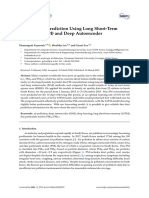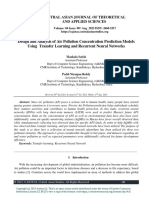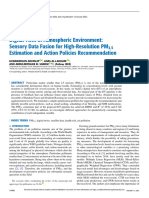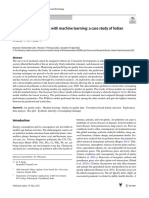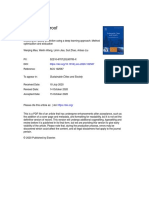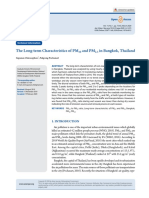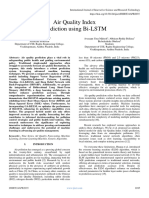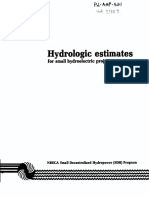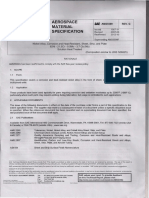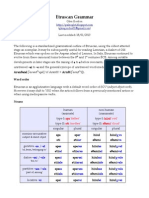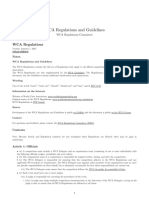A Hybrid Deep Learning Model For Forecasting PM2.5 Concentrations in Northern Thailand From Satellite Images
A Hybrid Deep Learning Model For Forecasting PM2.5 Concentrations in Northern Thailand From Satellite Images
Volume 10, Issue 2, February – 2025 International Journal of Innovative Science and Research Technology
ISSN No:-2456-2165 https://doi.org/10.5281/zenodo.14979453
A Hybrid Deep Learning Model for
Forecasting PM2.5 Concentrations in
Northern Thailand from Satellite Images
Chutinun Potavijit1; Parichart Pattarapanitchai2; Chalermrat Nontapa3*
1,2,3
Department of Statistics, Faculty of Science, Chiang Mai University, Chiang Mai, Thailand
Corresponding Author: Chalermrat Nontapa3*
Publication Date: 2025/03/10
Abstract: Air pollution is a significant environmental issue with extensive impacts, particularly concerning particulate
matter smaller than 2.5 microns (PM2.5), which poses serious public health risks, especially respiratory diseases such as
various diseases, ischemic heart disease, strokes, chronic obstructive pulmonary disease, tracheal, bronchus, lung cancer,
and even increased premature death rates. Northern Thailand is one of the areas with the most severe PM2.5 problems,
especially during the summer (February to May), primarily due to the large amount of agricultural field burning and forest
fires by ethnic groups after the harvest season. This research proposes a hybrid model of Convolution Neural Network (CNN)
and Long Short-Term Memory (LSTM) for PM2.5 concentration forecasting using satellite images of four environmental
variables: aerosol optical depth, temperature, precipitation, and ozone. These variables are important factors in the
occurrence of PM2.5. The efficiency of the CNN-LSTM model was assessed by comparing performance with classification
deep learning models (CNN, LSTM), Seasonal Autoregressive Integrated Moving Average with Exogenous Variables
(SARIMAX), and Multiple Linear Regression (MLR). The findings indicate that The CNN-LSTM model achieves higher
accuracy than the other models, achieving an R2 of 98.38%, MAPE of 2.47%, and significantly lower RMSE (3.0672 µg/m3)
and MAE (0.8560 µg/m3). In conclusion, this research highlights the important implications of supporting government policy
formulation and public preparedness to address the PM2.5 problem, which varies in severity across seasons.
Keywords: Air Pollution, PM2.5, Deep Learning, Satellite Images, Air Quality Forecasting, Northern Thailand.
How to Cite: Chutinun Potavijit; Parichart Pattarapanitchai; Chalermrat Nontapa. (2025). A Hybrid Deep Learning Model for
Forecasting PM2.5 Concentrations in Northern Thailand from Satellite Images. International Journal of Innovative
Science and Research Technology, 10(2), 1666-1673. https://doi.org/10.5281/zenodo.14979453.
I. INTRODUCTION forest fires during the summer (February to May), the
burning of fields, and agricultural forests by local ethnic
In recent years, PM2.5 has emerged as an air pollution groups after the harvest season. These activities result in
issue that requires immediate attention because PM2.5 has high levels of PM2.5, which significantly affect the health
widespread impacts, including significant health risks, of residents. For example, Chiang Mai, one of the northern
particularly respiratory diseases. Additionally, PM2.5 has provinces, has been ranked among the most polluted cities in
considerable economic effects by increasing the social costs the world. During the dry season, the air pollution levels in
associated with goods affected by PM2.5 pollution. The Chiang Mai often exceed World Health Organization (WHO)
occurrence of PM2.5 involves both direct and indirect standards by up to 20 times (World Health Organization,
processes. Direct factors contributing to PM2.5 include 2021). This period, often referred to as the "smog season," is
pollutants released directly from industrial sources or human caused by agricultural burning and forest fires set to prepare
activities, such as industrial factories, power generation, land for new plantations.
transportation, and wildfires. Indirect factors refer to
complex chemical reactions in the atmosphere influenced by Currently, air quality monitoring has seen numerous
environmental variables, including air pollutants and innovations, such as air quality monitoring stations, laser
meteorological factors such as aerosol optical depth (AOD), scattering methods, portable sensors, portable air quality
precipitation, ozone (O₃), and temperature. monitors, data from applications and websites, and satellite
imagery. However, using satellite imagery effectively for
In Thailand, the PM2.5 problem is particularly severe monitoring air quality over large areas and providing
in the northern region. The most common causes include continuous, verifiable data remains a challenge (UNEP,
IJISRT25FEB1154 www.ijisrt.com 1783
Volume 10, Issue 2, February – 2025 International Journal of Innovative Science and Research Technology
ISSN No:-2456-2165 https://doi.org/10.5281/zenodo.14979453
2022). This is because satellite image analysis is still characteristics from the data, and pooling layers that
complex and requires advanced technology for analyzing decrease the data dimensions obtained from convolutional
such data. One promising approach is the application of deep layers to reduce the number of parameters and unnecessary
learning models, especially Convolutional Neural Networks computations. These layers work in conjunction with fully
(CNNs), which are specifically designed for analyzing connected layers present in the hidden layers of ANNs to
image data or extracting deep features from large and enhance the processing efficiency of complex data structures
complex datasets with high efficiency. Additionally, Long such as images or videos, which are commonly used in
Short-Term Memory (LSTM) models possess unique applications like medical imaging and biometric user
capabilities to retain and learn sequential data relationships, identity authentication. The important layers in CNNs are the
such as time-series data, and capture complex temporal convolution layers and pooling layers.
relationships, such as variations in PM2.5 levels associated
with meteorological factors and other variables. Previous The convolution operation is defined by the following
studies (Ahmed et al., 2022; Kristiani et al., 2022) have equation:
demonstrated that CNNs and LSTM models are highly
effective in accurately predicting PM2.5 concentrations. C (m, n) ( I F )(m, n) F (i, j ) I (m i, n j )
Therefore, developing and optimizing these deep learning i j
(1)
classification models can enhance the accuracy of PM2.5
forecasts across various regions, particularly in areas lacking Where I is the input image, F is the kernel (filter), and
air quality monitoring stations or other high-cost air quality
C (m, n) is the output feature map in the position of (m, n) .
measurement tools.
The hybrid model is a highly promising approach to Max Pooling is widely utilized, and its function can be
enhancing the precision of PM2.5 forecasting by combining expressed with the following formula:
the strengths of different models. For instance, Zhang et al.
(2021) and Liu et al. (2022) used CNN to extraction spatial P(m, n, z ) max C (i, j, z ) (2)
( i , j )Rm ,n
features from satellite imagery, allowing them to account for
variations in PM2.5 levels due to spatial differences.
Additionally, LSTM networks were used to capture the Where P ( m, n , z ) is the result of the pooling operator at
temporal relationships in the data, learning the trends and position ( m, n) in k -th feature map, and C (i, j , z ) is the
variations in PM2.5 concentrations over time. To increase feature value at position (i, j ) inside the pooling region Ri , j
the accuracy of the model, Liu et al. (2022) incorporated both
ground station data and satellite imagery (multi-source data) in z-th feature map.
in training the model, enabling the model to learn from both
ground-based and satellite-based data simultaneously. ct wi xi ei (3)
However, there are some limitations that affect the accuracy
of the predictions. First, the ability to capture complex Where ct is the output vector, xi are the feature maps
spatial and temporal relationships with high uncertainty
remains a challenge, particularly in areas with rapid changes, after layer i and x0 is the input vector, wt is the weight
such as regions with heavy traffic or sudden weather vector, and ei is the bias vector.
changes. Second, the limited number of ground monitoring
stations that do not cover all areas may result in errors in
regions without monitoring data. B. LSTM
LSTM is a category of recurrent neural network (RNN)
This research aims to develop a new hybrid deep proposed to analyze sequential data and capture long-term
learning model combining CNN and LSTM to enhance the citation. Unlike traditional RNN, which is unable to
performance of classification models in forecasting PM2.5 summarize long-term dependencies because of the vanishing
concentrations in northern Thailand. The model utilizes gradient issue, the LSTM model has a unique architecture
satellite imagery data of four environmental variables: that enables them to update information regarding long-term
aerosol optical depth, temperature, precipitation, and ozone. citation (Li, Hua, & Wu, 2020). The structure of an LSTM
The proposed model's performance will be compared to that model consists of multiple cells, each containing three
of CNN, LSTM, SARIMAX, and MLR models. This important components: forget gate, input gate, and output
approach addresses the limitations of current air quality gate. Generally, the steps of an LSTM model unit at time t
monitoring methods and improves forecasting accuracy. can be carried out as follows:
II. METHODOLOGY The forget gate, which decides the amount of past
information to retained or discarded.
A. CNNs
CNNs are a category of Artificial Neural Networks ft ( wt [ pt 1 , xt ] e f ] (4)
(ANNs) developed by LeCun et al. (1989). In the
architecture of CNN, specific layers are added, including
convolutional layers that extraction significant
IJISRT25FEB1154 www.ijisrt.com 1784
Volume 10, Issue 2, February – 2025 International Journal of Innovative Science and Research Technology
ISSN No:-2456-2165 https://doi.org/10.5281/zenodo.14979453
Where the values obtained from the Sigmoid function Where, ot is the Output Gate value, ct is the present
range between 0 and 1. wt
is the weight matrix, pt 1 cell state, and tanh() is the Tanh function.
represents the output of the prior cell state, xt is the input to
C. Proposed Method
the cell state at time t , and e f is the bias term. This research proposes a CNN-LSTM model, a hybrid
The Input Gate handles the reception of new model that combines CNN and LSTM networks, to forecast
information and recording into each node. The first part PM2.5 concentrations in Northern Thailand for satellite
involves checking whether the update of the cell state needs imageries. First, four environmental variables (temperature,
to be updated or not. AOD, precipitation, and O₃) are input into the CNN. Then
use CNN to analyze and extracts spatial features from these
it ( wi [ pt 1 , xt ] ei ) (5) datasets to generate monthly PM2.5 concentration outputs.
Next, the estimation errors from the CNN are analyzed using
the LSTM, which is capable of handling sequential data to
The second part generates Ct (Candidate Values) in the identify patterns in the errors. Finally, the PM2.5
state when the input gate assign whether to update the cell concentrations obtained from the CNN are combined with
state, using the Tanh function. the errors analyzed by the LSTM to enhance prediction
accuracy. Can be expressed as an equation like this:
Ct tanh(wc [ pt 1 , xt ] ei ) (6)
yt ct ht t (9)
The Output Gate is responsible for preparing the
processed information by using the Sigmoid function ( ) to Where yt is the PM2.5 concentration (monthly), ct is
select which information will be sent out. The final step is
the PM2.5 concentration at time t (monthly) as forecast by
then passed through the Tanh function before being output.
CNN, ht is the error estimated by LSTM, and t is the
ot (wo [ pt 1 , xt ] eo ) (7) random bias. The CNN-LSTM model chart is as follows:
pt ot tanh(ct ) (8)
Fig 1: Architecture of CNN-LSTM Model
D. Data Collection Additionally, PM2.5 concentration data collected from
The data used in this research includes satellite imagery ground monitoring stations is also included. These datasets
of environmental variables affecting the occurrence of are gathered monthly, from January 2016 to December 2023,
PM2.5, including AOD, temperature, precipitation, and O3, covering the research area in Northern Thailand, which
is collected from Google Earth Engine. These data have been includes Chiang Mai, Chiang Rai, Lamphun, Lampang,
processed and stored in high-resolution GeoTIFF files, with Phrae, Nan, Phayao, Mae Hong Son, and Uttaradit.
each image having dimensions of 448 by 372 pixels..
IJISRT25FEB1154 www.ijisrt.com 1785
Volume 10, Issue 2, February – 2025 International Journal of Innovative Science and Research Technology
ISSN No:-2456-2165 https://doi.org/10.5281/zenodo.14979453
Fig 2: Research Area
The ozone data is collected from the Total Ozone PM2.5 concentrations data collected from the Air4Thai
Mapping Spectrometer and the Ozone Monitoring website (Pollution Control Department, n.d.) provides
Instrument aboard the Aura satellite (NASA, 2023). The monthly concentration measurements of PM2.5 from ground
AOD data is gathered from the MODIS Terra and MODIS monitoring stations across Northern Thailand. These data are
Aqua satellites using the MAIAC algorithm (NASA, 2023). collected from various sensors that provide reliable
Temperature and precipitation data are sourced from Terra measurements for monitoring air quality in the country.
Climate, a dataset that provides monthly climate predictions
using data from several sources (University of Idaho, 2023).
Fig 3: Satellite Images of Environmental Variables for March 2021 and Map of Monitoring Stations
in Northern Thailand: (I) AOD, (II) Temperature, (III) Ozone, (IV) Precipitation
E. Data Preprocessing The satellite imagery, stored in GeoTIFF format with
consistent dimensions of 448x372 pixels, is processed
The PM2.5 concentration data from the Air4Thai website using ‘rasterio’ library. After organizing the time-series
is cleaned by removing missing data. The data is then data, missing values in the satellite images are removed
organized by month and year, creating new features for to maintain data integrity. Subsequently, values are
each monitoring station monthly for each year. extracted from each satellite image variable based on the
IJISRT25FEB1154 www.ijisrt.com 1786
Volume 10, Issue 2, February – 2025 International Journal of Innovative Science and Research Technology
ISSN No:-2456-2165 https://doi.org/10.5281/zenodo.14979453
latitude and longitude coordinates of the air quality F. Model Evaluation Metric
monitoring stations that PM2.5 dataset. These extracted Mean Absolute Percentage Error (MAPE) is a metric
values are then used to create new features, enabling that assesses a model's accuracy by computing the average
accurate linkage between the two data sources. absolute percentage errors.
In this study, the dataset is split into two segments: 70%
is used for training the model, while 30% is allocated for 1 N
yi yˆi
testing, model development and performance evaluation. MAPE (%)
N
i 1 yi
100 (8)
Furthermore, before applying the MLR and SARIMAX
models for performance comparison, we conducted an Mean Absolute Error (MAE) is a metric that measures
analysis of the Variance Inflation Factor (VIF) to evaluate a model's accuracy by computing the average absolute error.
multicollinearity between the independent variables (AOD,
N
1
y yˆ
Ozone, Temperature, and Precipitation). Only variables with
a VIF of less than 5 were included in the models to avoid MAE i i
(9)
N i 1
multicollinearity issues.
Root Mean Square Error (RMSE) is a metric that
Table 1: VIF for Independent Variables
assesses a model's accuracy by taking the square root of the
Variables VIF
average squared errors.
AOD 1.9204
Ozone 2.4748
1
Temperature 2.6789
yi yˆi
N
RMSE
2
(10)
Precipitation 1.9496 i 1
N
Additionally, stationarity of the data was examined use 2
Coefficient of Determination ( R ) measures how well
the Augmented Dickey-Fuller (ADF) test and the
independent variables explain dependent variable variance.
Kwiatkowski-Phillips-Schmidt-Shin (KPSS) test.
Table 2: Stationarity Test Results N ( yi yˆi ) 2
R 2 (%) 1 iN1 100 (4)
Test Test Statistic p-value
Alternative i 1 ( yi y ) 2
Hypothesis
ADF
-4.3528 0.01 stationary
Test III. RESULTS AND DISCUSSION
KPSS
0.14064 0.10 stationary The evaluation results of the CNN-LSTM model,
Test
compared with CNN, LSTM, MLR, and SARIMAX models
As shown in Table 1, the VIF values for all variables for monthly PM2.5 concentration forecasting in Northern
were below the acceptable threshold of 5, indicating no Thailand, are shown in Table 3. These results are based on
significant multicollinearity issues. Furthermore, Table 2 satellite imagery data of four environmental variables (AOD,
highlights that all variables satisfy the stationarity criteria Ozone, Temperature, and Precipitation) collected from
under both ADF and KPSS tests. January 2016 to December 2023. The experiments were
conducted using Python.
Table 3: Model Performance for Monthly PM2.5 Forecasting in Northern Thailand using Satellite Data
Models MAE MAPE (%) RMSE R2 (%)
CNN 6.0549 24.19 11.1219 78.75
LSTM 6.5831 25.69 11.9246 77.63
MLR 7.2866 31.31 11.9516 75.46
SARIMAX 6.7979 33.74 9.7596 82.48
CNN-LSTM 0.8560 2.47 3.0672 98.38
As shown in the evaluation results in Table 3, the CNN- R2 of 98.38%. Additionally, when considering individual
LSTM model outperforms other models in forecasting models, the CNN model performs better than LSTM, MLR,
monthly PM2.5 concentrations in Northern Thailand, and SARIMAX, demonstrating that the CNN model is
achieving the best results across all evaluation metrics, with highly effective in forecasting image datasets.
an MAE of 0.8560, MAPE of 2.47%, RMSE of 3.0672, and
IJISRT25FEB1154 www.ijisrt.com 1787
Volume 10, Issue 2, February – 2025 International Journal of Innovative Science and Research Technology
ISSN No:-2456-2165 https://doi.org/10.5281/zenodo.14979453
Fig 4: MAPE (%) Comparison Across Different Models
Figure 5 presents the actual and forecasted PM2.5 close agreement with the actual values, showing the high
concentrations for the test dataset using the CNN-LSTM accuracy and effectiveness of the model in forecasting
model. The findings indicate that the forecast values are in PM2.5 concentrations for satellite imagery.
Fig 5: Comparison of Actual Values and Forecasted Values of PM2.5 for the CNN-LSTM Model
IV. CONCLUSION image data of environmental variables influencing PM2.5 in
Northern Thailand. The model offered is in comparison with
The use of a hybrid deep learning model for estimate CNN, LSTM, MLR, and SARIMAX models. The evaluation
PM2.5 concentrations from satellite imagery has extended results demonstrate that the CNN-LSTM hybrid model
significant attention from researchers in recent years. This is achieves superior performance compared to the other
due to the current limitations in air quality monitoring, such models. Future research may further enhance the model and
as high costs, inadequate coverage of monitoring devices, or evaluate the impact of additional environmental variables to
even geographical limitations that may result in inaccurate improve forecasting accuracy.
readings from existing air quality monitoring equipment.
Therefore, this research focuses on utilizing publicly ACKNOWLEDGMENT
available satellite imagery, which can be accessed at any
time and covers the required study area comprehensively, to This research was supported by the Government of
forecast PM2.5 concentrations. A hybrid deep learning Canada, Canada-ASEAN Scholarships and Educational
model combining CNN and LSTM is applied to real satellite Exchanges for Development (SEED 2023-2024).
IJISRT25FEB1154 www.ijisrt.com 1788
Volume 10, Issue 2, February – 2025 International Journal of Innovative Science and Research Technology
ISSN No:-2456-2165 https://doi.org/10.5281/zenodo.14979453
REFERENCES
[1]. Ahmed S, Khan MA, Rehman S. Estimation of
ground PM2.5 concentrations in Pakistan using
convolutional neural network and multi-pollutant
satellite images. Remote Sens 2022;14(7):1735.
[2]. Kristiani E, Lin H, Lin J-R, Chuang Y-H, Huang C-
Y, Yang C-T. Short-term prediction of PM2.5 using
LSTM deep learning methods. Sustainability
2022;14(4):2068.
[3]. LeCun, Y., Boser, B., Denker, J., Henderson, D.,
Howard, R., Hubbard, W., & Jackel, L. (1989).
Handwritten digit recognition with a back-
propagation network. Advances in Neural
Information Processing Systems, 2, 1-4.
[4]. Li, T., Hua, M., & Wu, X. (2020). A Hybrid CNN-
LSTM Model for Forecasting Particulate Matter
(PM2.5). IEEE Access, 8, 26933-26940.
[5]. Liu, Y., Zhang, Z., Liu, X., & Liu, J. (2022). Hybrid
deep learning model for PM2.5 prediction using
satellite images and ground-level observations.
Atmospheric Environment, 271, 118999.
[6]. NASA. (2023). MODIS 061 MCD19A2 Granules:
Aerosol Optical Depth (AOD) data [Dataset]. NASA
Goddard Space Flight Center.
https://developers.google.com /earth-
engine/datasets/catalog/MODIS_061_MCD19
A2_GRANULES
[7]. NASA. (2023). Total Ozone Mapping Spectrometer
(TOMS) merged ozone data [Dataset]. NASA
Goddard Space Flight Center.
https://developers.google.com/earth-
engine/datasets/catalog/TOMS_MERGED
[8]. Pollution Control Department. (n.d.). Air quality
monitoring system. Air4Thai. Retrieved August 26,
2024, from http://air4thai.pcd.go.th/webV3/#/Home
[9]. The World Health Organization. (2021). WHO global
air quality guidelines: Particulate matter (PM2.5 and
PM10), ozone, nitrogen dioxide, sulfur dioxide and
carbon monoxide. World Health Organization.
https://www.who.int/publications/i/item/9789240034
228
[10]. University of Idaho. (2023). TerraClimate: Monthly
climate and climatic water balance for global
terrestrial surfaces [Dataset].
https://developers.google.com/ earth-
engine/datasets/catalog/IDAHO_EPSCOR_TER
RACLIMATE
[11]. UNEP. (2022). Applications of Remote Sensing for
Air Pollution Monitoring in Thailand: An Early
Warning for Public Health. Springer.
https://link.springer.com /chapter/10.1007/978-981-
19-8765-6_1
[12]. Zhang, X., et al. (2021). Spatio-temporal PM2.5
concentration prediction using a hybrid CNN-LSTM
model with satellite data. Remote Sensing of
Environment.
IJISRT25FEB1154 www.ijisrt.com 1789
Volume 10, Issue 2, February – 2025 International Journal of Innovative Science and Research Technology
ISSN No:-2456-2165 https://doi.org/10.5281/zenodo.14979453
AUTHORS’ INFORMATION FORM
A Hybrid Deep Learning Model for Forecasting PM2.5 Concentrations in Northern
Paper Title:
Thailand from Satellite Images
Corresponding Author:
Chalermrat Nontapa, (Email: chalermrat.n@cmu.ac.th)
(Author Name & Email)
First Author – Information
First Name Chutinun Last Name Potavijit
Designation - Department Statistics
University Chiang Mai University Mail ID Chutinun_pota@cmu.ac.th
Contact No. +66921059029 ORCID ID -
Residential Address 69 Moo 18, Ba O Don Chai, Mueang, Chiang Mai, Thailand, 57000
Second Author – Information
First Name Parichart Last Name Pattarapanitchai
Designation - Department Statistics
University Chiang Mai University Mail ID parichart.p@cmu.ac.th
Contact No. +66868018418 ORCID ID -
Residential Address Department of Statistics, Faculty of Science, Chiang Mai University, Thailand
Second Author – Information
First Name Chalermrat Last Name Nontapa
Designation Acting Capt. Department Statistics
University Chiang Mai University Mail ID chalermrat.n@cmu.ac.th
Contact No. +66935793488 ORCID ID https://orcid.org/0009-0006-0628-697X
Residential Address Department of Statistics, Faculty of Science, Chiang Mai University, Thailand
AUTHOR’S BIOGRAPHY
C. Potavijit (Chutinun Potavijit) obtained her Bachelor’s degree at Department of Mathematics,
Faculty of Science, Chiang Mai University. Currently, she is a master’s student in Applied Statistics and
Data Analytics at Chiang Mai University. Her current research interests are hybrid deep learning models.
P. Pattarapanitchai (Parichart Pattarapanitchai) received her Bachelor’s and Master’s degrees in
Statistics from Silpakorn University. She then obtained her Ph.D. in Statistics from Thammasat
University. Currently, she is a lecturer in Statistics at Chiang Mai University. Her recent research focuses
on statistical modeling in medical and forensic sciences.
C. Nontapa (Chalermrat Nontapa) is a Lecturer at Department of Statistics, Faculty of Science,
Chiang Mai University. His research focuses on Time Series, Machine Learning and Optimization. This
forecast technique will be applied for hybrid model in time series data.










